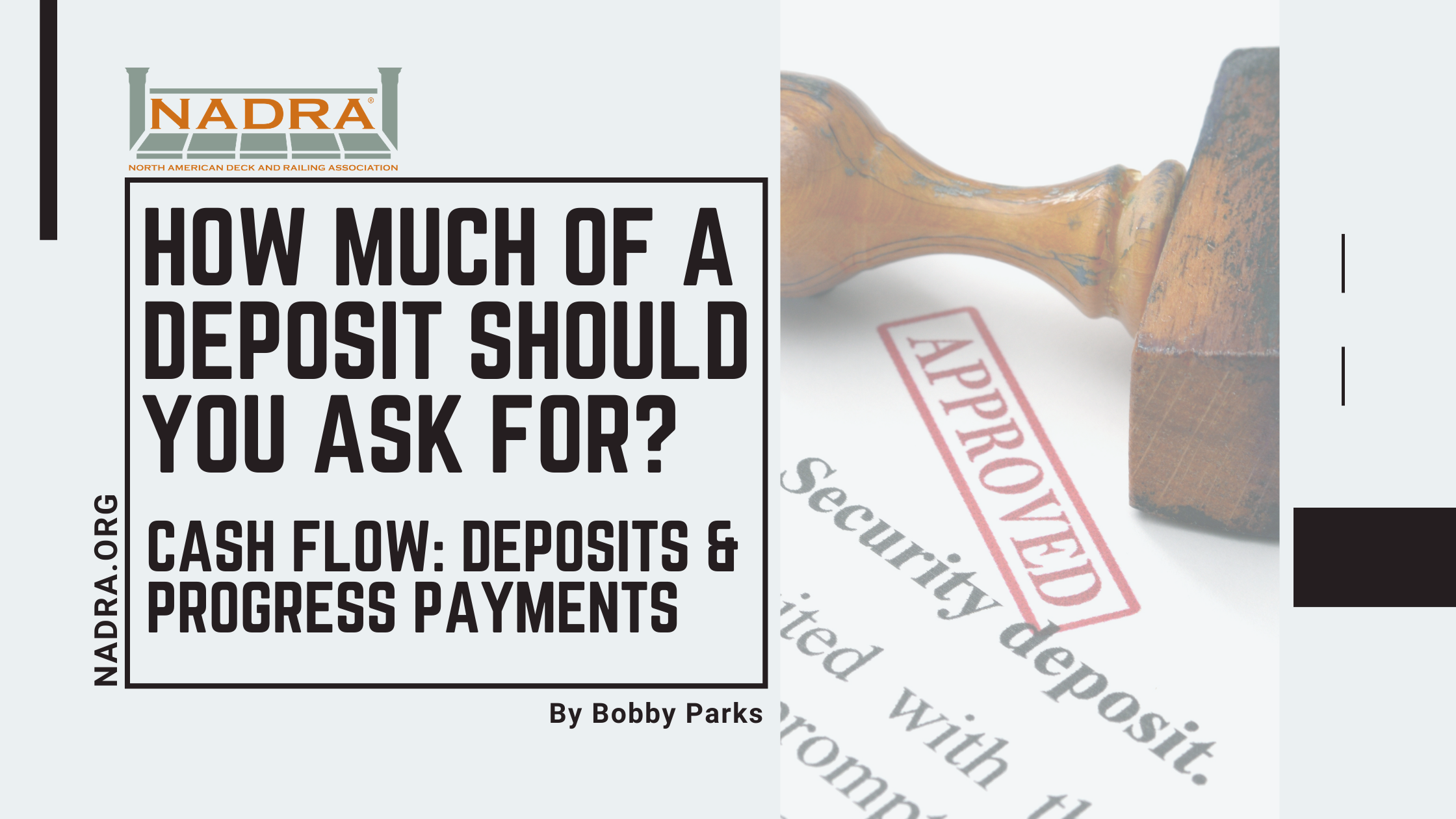How Much of a Deposit Should You Ask For?
Cash Flow: Deposits & Progress Payments
How much of a deposit should you get when writing up a contract? Is 10%, enough? Is 50% too much? Is 25% a good average amount? Is a third down, third at a certain point of progress, and a third upon completion a simpler way to do it? Is not accepting a deposit at all and waiting to collect in full once a project is completed a safe practice? There are stories of homeowners paying deposits and never seeing the contractor again as there are stories of contractors having difficulty collecting payment once a job is completed. When a job is contracted the homeowner is hoping they’ll have their expectations met and that their money is not at risk. Contractors simply want to satisfy the customer and get paid in full. State laws regulate how contracts are written and in some cases what deposits are allowed, so check into this before following any of my suggestions. For example, California allows no more than 10% of the cost of the job or $1000, whichever is less, although there are exceptions for qualified contractors who have higher-limit blanket payment and performance bonds. But assuming you have some legal leeway which most states do, having a payment process that’s fair and minimizes risk for both the customer and contractor simplifies things.
Large Deposits Equal Borrowed Money
Taking a large deposit especially with multiple jobs and job backlogs may mean you’re working with borrowed money instead of money you’ve earned as it’s worked into cash flow. In essence, some are taking more than their gross profit before they ever step on the job. It’s easy to become dependent on the upfront advanced money versus the earned money. One question to ask yourself is; “If your business had to close today, could you give everyone their deposit back”? If you couldn’t, even if you bankrupted, it’s possible criminal charges could be filed against you. So as long as the music never stops and you continue to sell and build jobs this may never catch up with you. But if the music ever stops, that’s when the problems arrive. Although cash flow comes from multiple areas, in my opinion, deposits collected before a job starts should be minimized so that you’re not using these funds for other projects and balanced in a way that you could refund it if circumstances required. Progress payments and final payments should account for the predominant cash flow you operate off of as you’ve earned them by delivering work.
A Mix of Payments for Steady Cash Flow
For me, it was about getting less upfront, a payment at the job start, and more as the job progressed. I split what might be considered a 25% deposit into two collections. On smaller to midsize jobs, 10% was collected as a “contract deposit” at contract signing, and a second deposit of 15% as a “start-up payment”, and then weekly progress payments. With larger projects, 5% or a flat figure was collected as a contract deposit as I only wanted enough to have a customer’s commitment to the project and secure a spot on our build schedule. Costly special order items ordered before a job start would have been an exception.
I had several jobs going on at once with job sizes that took 2 weeks to 2.5 months to deliver. I had a formula for estimating how long each job would take based on the contract amount. I arranged the payment schedule to allow for the 1st deposit, 2nd deposit at startup, divided the bulk into weekly progress payments, and then the balance. We did a lot of porches and watertight decks so the latter progress payments were set up when “paint ready” or “after paint “etc. I didn’t want a disproportionate amount of dollars held up because of simple things like gutters, electrical trim out, or final inspections. I also had a clause that stated if we reached the “paint ready” stage before drawing out the specified weekly draws that all “weekly progresses” were due. At the end of the job, there was 10% or less as a balance. All of this was written into the contract as a payment schedule.
Customers could see the progress and I never had trouble collecting. Checks were left for me to pick up, given to the crew leader who often made the deposit, wire transferred, or paid by credit card. If we lost a day to weather, I bumped the request back a day, etc. I didn’t set it up like some might do based on milestones such as framing completion, or once decking was installed as our porch, deck, and patio combination jobs just didn’t work that way. We focused on multiple areas at a time to prepare for subs to get in as soon as possible. This allowed me to not be the customer’s bank and equaled a “pay as you go” scenario. It also minimized my risk so in the end, I wasn’t owed a lot of money. If a customer didn’t pay me the final, it wasn’t going to have a big effect on my business as the percentage amounts were minimal. In all my years of contracting and in delivering $40 million in jobs, I was only taken for $2000.
If it’s a smaller job and the start date is close to the contract date I can see getting 25% when contracting as you’re not going to be holding the money for long. But if it’s several weeks or months I’d look at that differently. Taking 5%-10% at contracting and 15%-20% when you begin funds the job starts and keeps you from using deposit money to pay for jobs you’re already working on. You’re more likely to use that customer’s money to pay for the cost of delivering their job. If your company is profitable this is a healthier way to work, whereas if you’re in need of heavy deposit money to pay bills there’s probably an underlying financial problem.
A Third, A Third, A Third
Many contractors like the third, third, third approach. Depending on the job size and the depth of your pockets or line of credit, dividing the payment structure into thirds may work fine. Those that are good money managers plan and work with this approach well. But you are working with a lot of upfront money with that large of a deposit if you’ve built up a job backlog and you’ve collected this from multiple customers. It’s a simple formula, but for many that want to avoid getting ahead of the job with heavy upfront payments, consider the options mentioned here. Employees and subs want to be paid every week so for me, it was about having the week to week cash flow that came in from multiple jobs mixed with various payments. This allowed for constant cash flow without getting caught up in a situation where you are owed a lot of money but yet can’t pay your weekly bills.
No Deposit: Just Pay Us When We’re Done
There are contractors that don’t collect anything upfront and wait until a job has been completed. Although this may sound good to a customer and you may be proud to say it, it can put you at risk. Most contractors doing this operate with lines of credit and they basically finance the job during construction. With small jobs or contract amounts where the exposure is minimal, this may be fine. But with larger jobs, especially for smaller contractors, operating this way can put a strain on operational cash flow. At some point, you’ll cross paths with a customer that can’t or won’t pay which may create serious issues. If you were taking progress payments you would have known the customer was going to have “pay problems” sooner and the risked amount was less.
Also, customers who don’t put up a deposit may be more likely to try and cancel the contract versus those who have paid and realize their deposit could be forfeited. If you have a job backlog of several weeks to months, requiring customers to put some skin in the game shows a true commitment. In my opinion, it’s a requirement to be included in the build schedule as it will make it more challenging to sell jobs as your schedule extends out even further.
Too Large of Deposit Request Can Cost You the Job
I only mention 50% deposits because I’ve heard some contractors mention that’s what they take and I’ve noticed online discussions that included this number. Asking for large deposits such as 50% will create reluctance with many customers and it may be why they didn’t choose you for the project even though you may not know that. And honestly, they’re putting themselves at risk if they put that much upfront so I wouldn’t think many would agree to this. Why should they give what could be tens of thousands of dollars in some cases to someone they just met and wait weeks or months for you to start the job? A lot can happen during that time period.
*Side Note:
One thing I learned after the downturn that began in 2007 was how to operate without a bank line of credit as most were withdrawn from contractors at that time. It was like working a trapeze act without a net. You learned to work with only the cash flow you generated and not with a bank line. I became a better business operator as there was no fallback funding option. Structuring various payment types in a way that provided steady and constant cash flow was crucial.
Bobby Parks / Instagram: @Bobbyparks007
Copyright December 1st, 2020 – Bobby Parks





